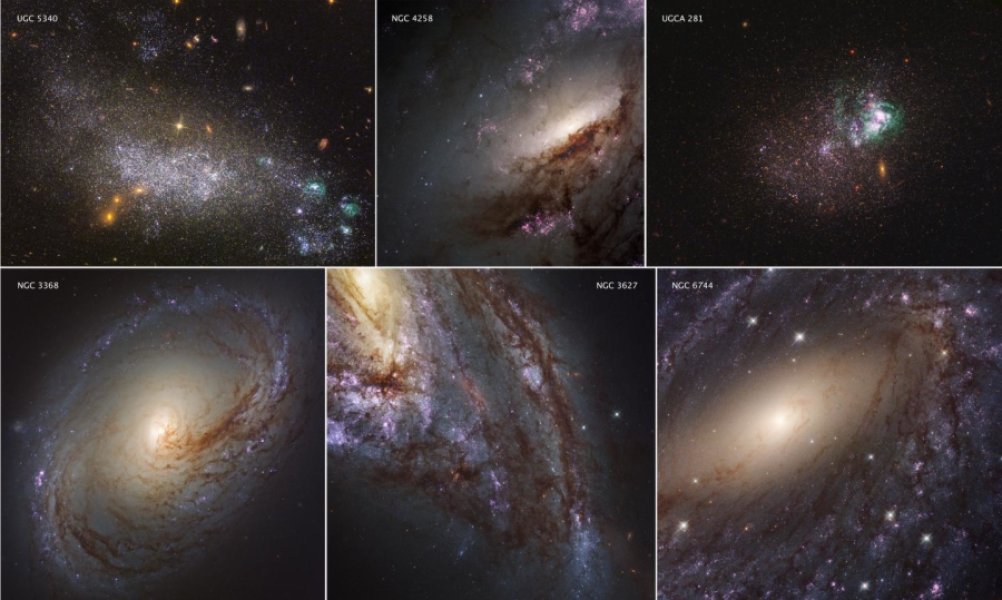
Capitalizing on the unparalleled sharpness and spectral range of NASA's Hubble Space Telescope, an international team of astronomers is releasing the most comprehensive, high-resolution ultraviolet-light survey of nearby star-forming galaxies.
The researchers combined new Hubble observations with archival Hubble images for 50 star-forming spiral and dwarf galaxies in the local universe, offering a large and extensive resource for understanding the complexities of star formation and galaxy evolution. The project, called the Legacy ExtraGalactic UV Survey (LEGUS), has amassed star catalogs for each of the LEGUS galaxies and cluster catalogs for 30 of the galaxies, as well as images of the galaxies themselves. The data provide detailed information on young, massive stars and star clusters, and how their environment affects their development.
"There has never before been a star cluster and a stellar catalog that included observations in ultraviolet light," explained survey leader Daniela Calzetti of the University of Massachusetts, Amherst. "Ultraviolet light is a major tracer of the youngest and hottest star populations, which astronomers need to derive the ages of stars and get a complete stellar history. The synergy of the two catalogs combined offers an unprecedented potential for understanding star formation."
How stars form is still a vexing question in astronomy. "Much of the light we get from the universe comes from stars, and yet we still don't understand many aspects of how stars form," said team member Elena Sabbi of the Space Telescope Science Institute in Baltimore, Maryland. "This is even key to our existence -- we know life wouldn't be here if we didn't have a star around."
The research team carefully selected the LEGUS targets from among 500 galaxies, compiled in ground-based surveys, located between 11 million and 58 million light-years from Earth. Team members chose the galaxies based on their mass, star-formation rate, and abundances of elements that are heavier than hydrogen and helium. The catalog of ultraviolet objects collected by NASA's Galaxy Evolution Explorer (GALEX) spacecraft also helped lay the path for the Hubble study.
The team used Hubble's Wide Field Camera 3 and the Advanced Camera for Surveys over a one-year period to snap visible- and ultraviolet-light images of the galaxies and their most massive young stars and star clusters. The researchers also added archival visible-light images to provide a complete picture.
The star cluster catalogs contain about 8,000 young clusters whose ages range from 1 million to roughly 500 million years old. These stellar groupings are as much as 10 times more massive than the largest clusters seen in our Milky Way galaxy.
The star catalogs comprise about 39 million stars that are at least five times more massive than our Sun. Stars in the visible-light images are between 1 million and several billion years old; the youngest stars, those between 1 million and 100 million years old, shine prominently in ultraviolet light.
The Hubble data provide all of the information to analyze these galaxies, the researchers explained. "We also are offering computer models to help astronomers interpret the data in the star and cluster catalogs," Sabbi said. "Researchers, for example, can investigate how star formation occurred in one specific galaxy or a set of galaxies. They can correlate the properties of the galaxies with their star formation. They can derive the star-formation history of the galaxies. The ultraviolet-light images may also help astronomers identify the progenitor stars of supernovas found in the data."
One of the key questions the survey may help astronomers answer is the connection between star formation and the major structures, such as spiral arms, that make up a galaxy.
"When we look at a spiral galaxy, we usually don't just see a random distribution of stars," Calzetti said. "It's a very orderly structure, whether it's spiral arms or rings, and that's particularly true with the youngest stellar populations. On the other hand, there are multiple competing theories to connect the individual stars in individual star clusters to these ordered structures.
"By seeing galaxies in very fine detail -- the star clusters -- while also showing the connection to the larger structures, we are trying to identify the physical parameters underlying this ordering of stellar populations within galaxies. Getting the final link between gas and star formation is key for understanding galaxy evolution."
Team member Linda Smith of the European Space Agency (ESA) and the Space Telescope Science Institute added: "We're looking at the effects of the environment, particularly with star clusters, and how their survival is linked to the environment around them."
The LEGUS survey will also help astronomers interpret views of galaxies in the distant universe, where the ultraviolet glow from young stars is stretched to infrared wavelengths due to the expansion of space. "The data in the star and cluster catalogs of these nearby galaxies will help pave the way for what we see with NASA's upcoming infrared observatory, the James Webb Space Telescope, developed in partnership with ESA and the Canadian Space Agency (CSA)," Sabbi said.
Webb observations would be complementary to the LEGUS views. The space observatory will penetrate dusty stellar cocoons to reveal the infrared glow of infant stars, which cannot be seen in visible- and ultraviolet-light images. "Webb will be able to see how star formation propagates over a galaxy," Sabbi continued. "If you have information on the gas properties, you can really connect the points and see where, when, and how star formation happens."
Hi! I am a robot. I just upvoted you! I found similar content that readers might be interested in:
http://www.dailymail.co.uk/sciencetech/article-5741645/Incredible-Hubble-images-nearest-galaxies-explain-stars-form.html
Downvoting a post can decrease pending rewards and make it less visible. Common reasons:
Submit